What’S the Secret to Navigating Tokyo’S Complex Subway System Like a Pro?
To navigate Tokyo's subway system like a pro, you'll need to familiarize yourself with the color-coded maps and understand the significance of station numbers and line colors. Equip yourself with a PASMO or Suica card for convenient pay-as-you-go travel, and always opt for the English language option on ticket machines to streamline the process. Consider downloading a reliable subway map app, like Tokyo Subway Navigation or Google Maps, to stay updated on real-time transit changes and station exits. Don't forget to plan your transfers early and avoid peak travel times for a smoother commute. With these tips, you'll master the art of moving through Tokyo's subway maze and discover even more strategies for efficient city navigation.
Understanding the Map Layout
To effectively navigate Tokyo's subway system, you'll need to familiarize yourself with its color-coded map. Start by identifying the main stations that serve as hubs for multiple lines. These are typically marked with larger symbols or different colors. You'll often find these stations in major districts like Shibuya, Shinjuku, and Tokyo Station itself.
Understanding the map's layout also involves recognizing the symbols that indicate the type of service each line offers. For example, some lines have express services that skip certain stations to speed up your journey. These are usually marked with special icons next to the line name or color. Keep an eye out for these as they can save you significant time, especially during peak hours.
Additionally, don't overlook the station numbers that accompany each stop on the map. These can be incredibly helpful when planning your route or when you need to quickly find a station on large, busy maps. Each line has a unique letter prefix followed by a number, making it easier to locate your current or next stop without having to decipher complex station names.
Decoding Line Colors and Names
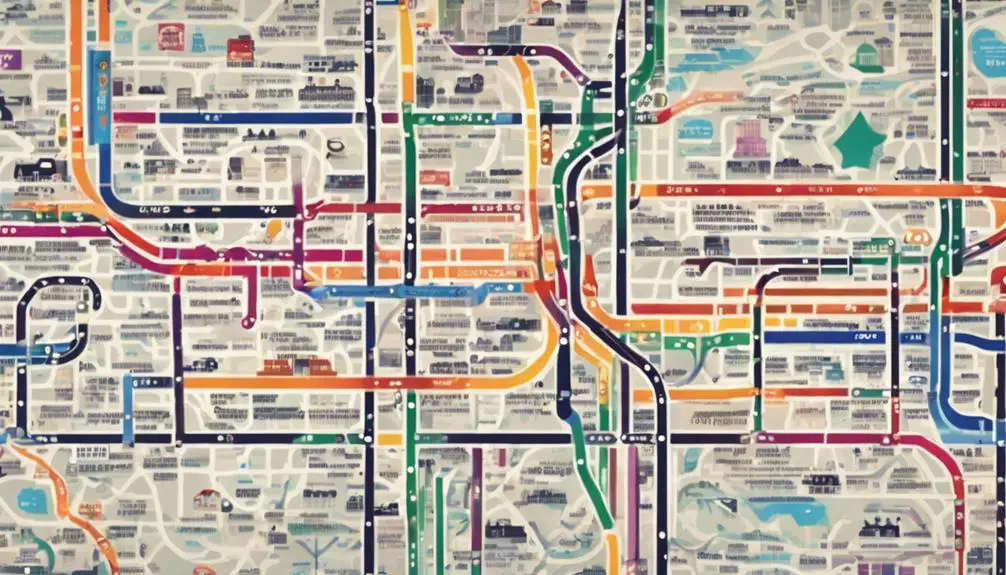
Understanding Tokyo's subway line colors and names simplifies traversing the system. Each line is distinctly marked with a color and a unique name, making it easier for you to identify your route quickly. You'll find that this color-coding is intuitive—blue for the Ginza Line, red for the Marunouchi Line, and so on.
Here's a quick guide to help you associate some of the major lines with their respective colors and areas they serve:
| Line Name | Color | Key Areas Served |
|---|---|---|
| Ginza | Orange | Asakusa, Ueno, Ginza, Shibuya |
| Marunouchi | Red | Ikebukuro, Tokyo, Shinjuku |
| Yamanote | Green | Tokyo's major city loop |
Familiarizing yourself with these colors and names will allow you to move through stations more confidently. Remember, the signs in the stations and the maps will always use these color codes. This system is designed to be foreigner-friendly, so even if you don't speak Japanese, you can find your way. As you get used to the colors, you'll navigate like a local, moving from one point to another with ease.
Mastering Ticket Machines
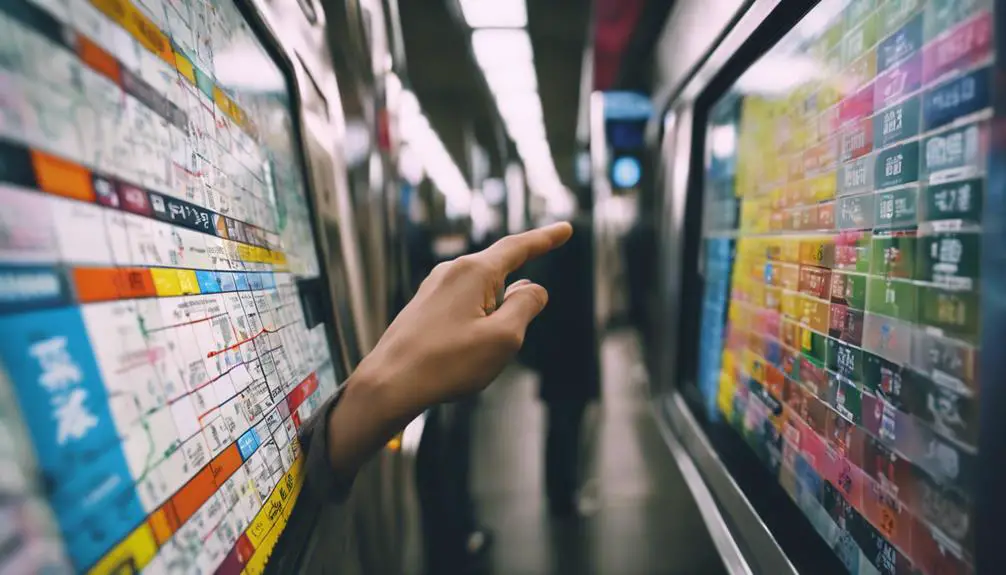
Now that you're familiar with line colors and names, let's explore how to use the ticket machines effectively.
When you approach a ticket machine in Tokyo's subway, you'll notice it's equipped with an English language option, making it easier for you to navigate. Simply touch the button to switch to English and follow the clear instructions displayed.
Start by selecting your destination. You can find it on the large map above the machine, which shows all stops and corresponding ticket prices. Once you've located your stop, note the price next to it and return to the machine. Enter this price by pressing the appropriate buttons, or choose your destination directly from a digital list, if available.
After choosing your fare, it's time to pay. Tokyo's ticket machines accept both cash and credit cards, so insert your payment when prompted. The machine will then dispense your ticket, along with any change needed.
Lastly, always double-check your ticket before leaving the machine. Verify it reflects your correct destination and fare paid. This simple check can save you time and hassle later, guaranteeing you're all set for a smooth ride through Tokyo.
Choosing the Right Pass
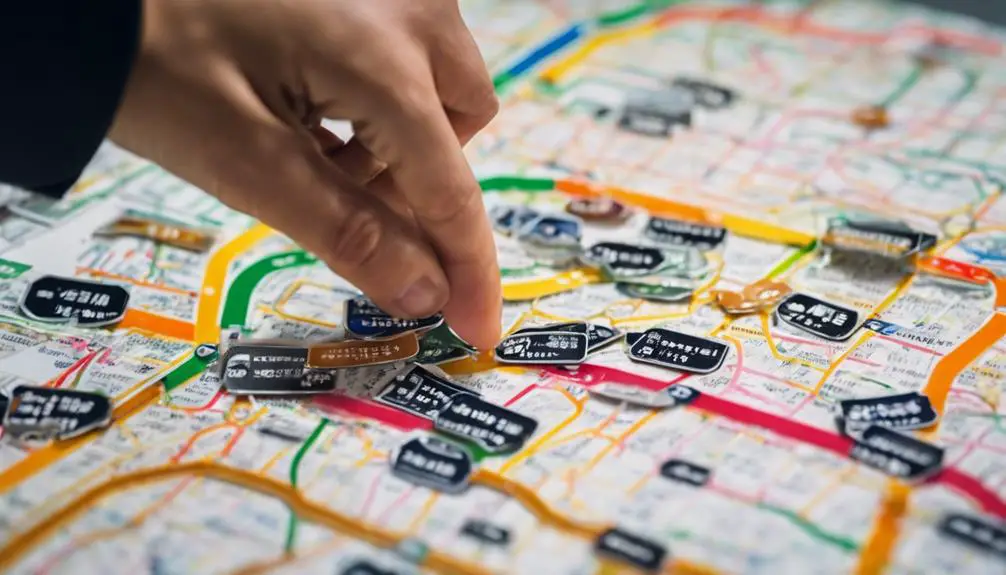
As you explore Tokyo, selecting the right travel pass can greatly streamline your subway experience.
You'll need to understand the different types of travel passes available and how they compare regarding benefits.
This knowledge will help you maximize both convenience and cost savings during your stay.
Types of Travel Passes
Choosing the right travel pass can greatly simplify your navigation through Tokyo's extensive subway network. Tokyo offers a variety of passes tailored to different needs, and you'll find that selecting the best one for your trip can make a huge difference in how smoothly your journey goes.
First, consider the Tokyo Metro 24-hour Ticket. It's perfect if you're planning a day packed with sightseeing. This pass allows unlimited rides on all Tokyo Metro lines but remember, it doesn't cover the Toei Subway lines.
If you're staying longer and want more extensive coverage, check out the Tokyo Combination Ticket. This pass covers both Tokyo Metro and Toei Subway lines, giving you access to a broader network. It's available in 24, 48, and 72-hour increments, ideal for a weekend trip or a short stay.
For those focusing on central Tokyo, the Toei One-day Pass might be your best bet. It only covers the Toei lines, which navigate major tourist spots efficiently.
Lastly, the PASMO and Suica cards offer flexible travel options with pay-as-you-go functionality, allowing you to travel across almost all of Tokyo's public transport systems. You'll just need to load them with funds as required.
Pass Benefits Comparison
Comparing the benefits of each pass will help you determine which best suits your travel needs in Tokyo.
The Tokyo Metro 24-hour Ticket, for instance, is ideal if you're planning a day packed with activities across the city. It's affordable and lets you explore without worrying about multiple fares.
However, if you're staying longer and aim for broader coverage, the Pasmo or Suica cards are your go-to options. These rechargeable cards not only cover multiple transport systems including buses and trains but also allow you to make purchases at various stores and vending machines.
For the frequent traveler or someone with a varied itinerary, the Tokyo Combination Ticket offers even greater flexibility. It covers all Tokyo Metro and Toei Subway lines plus buses, and even includes some private railways. This might be pricier, but it's unmatched in convenience if you're jumping between wide-ranging locations.
Before you choose, think about how many days you'll be traveling and how extensively you plan to use the subway. Remember, buying the right pass isn't just about saving money—it's about maximizing your time and experience in Tokyo.
Choose wisely based on your itinerary and mobility needs.
Tips for Efficient Transfers
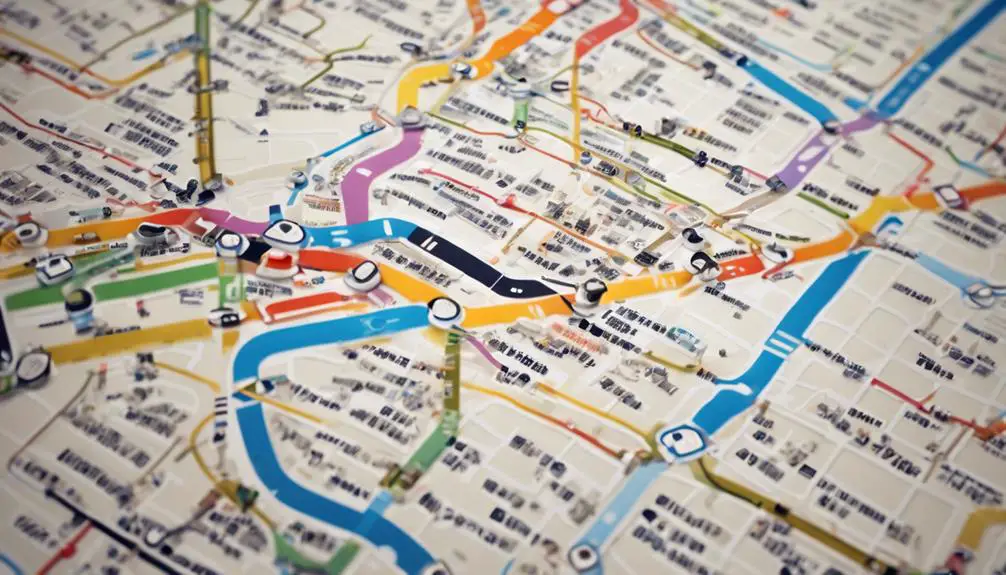
Mastering efficient transfers in Tokyo's subway system can make your travel smoother and faster.
Start by planning your routes early to avoid confusion and delays during your journey.
Additionally, knowing when peak travel times occur helps you dodge the busiest periods, while mobile navigation apps keep you updated on the go.
Plan Transfer Routes Early
To streamline your journey, it's crucial to plan your transfer routes before traversing Tokyo's subway system. With over 13 subway lines and more than 250 stations, mapping out your path can save you a significant amount of time and confusion.
You'll want to familiarize yourself with the major transfer hubs, such as Shibuya, Shinjuku, and Ikebukuro, where multiple lines intersect.
Start by downloading a reliable subway map app specifically designed for Tokyo's network. These apps typically offer real-time updates, route options, and even estimated travel times. Before you head out, plug in your destination to see your options.
Look for routes that minimize transfers; direct routes might take a slightly longer path but can be quicker than multiple changes.
If you must transfer, check the proximity of transfer points within the stations. Some stations are vast, requiring a lengthy walk from one line to another. Knowing this in advance can help you decide if a different route with a closer transfer might be more efficient.
Recognize Peak Travel Times
Recognizing peak travel times in Tokyo's subway system can help you avoid delays and enjoy smoother transfers. During these busy hours, stations are bustling, and trains are packed, making it essential for you to plan your journey around them if you're looking for a less stressful experience.
Peak hours generally occur in the morning from 7:30 AM to 9:30 AM and in the evening from 5:00 PM to 7:00 PM. If your schedule is flexible, consider traveling outside these times.
Here's a quick glance at how emotions fluctuate during different travel times in Tokyo:
| Time of Day | Crowd Level | Emotional Impact |
|---|---|---|
| 7:30 – 9:30 AM | Very High | Stressful |
| 12:00 – 1:00 PM | Moderate | Tolerable |
| 5:00 – 7:00 PM | Very High | Exhausting |
| After 8:00 PM | Low | Relieved |
Traveling during off-peak hours can transform your subway experience from a chaotic rush to a more serene journey. You'll find yourself more relaxed and able to appreciate the efficiency and convenience of Tokyo's subway system. Adjusting your travel time isn't just about comfort; it's about experiencing the city's rhythm in a way that suits you best.
Utilize Mobile Navigation Apps
While adjusting your travel times can enhance your subway experience, using mobile navigation apps will streamline your transfers even further. These apps don't just map out the quickest route from point A to B; they provide real-time updates and insider tips that can make or break your commute in Tokyo's labyrinthine subway.
Here's how you can leverage these apps to navigate like a local:
- Real-Time Updates: Stay ahead of any service disruptions or delays. These apps alert you instantly, allowing you to reroute swiftly and avoid getting stuck.
- Station Exit Information: Know exactly which exit to take for the shortest path to your destination. This cuts down walking time and confusion when you surface in bustling Tokyo.
- Transfer Efficiency: These apps highlight the most efficient transfer points and times, minimizing your wait and ensuring you catch the best connections.
Rush Hour Strategies
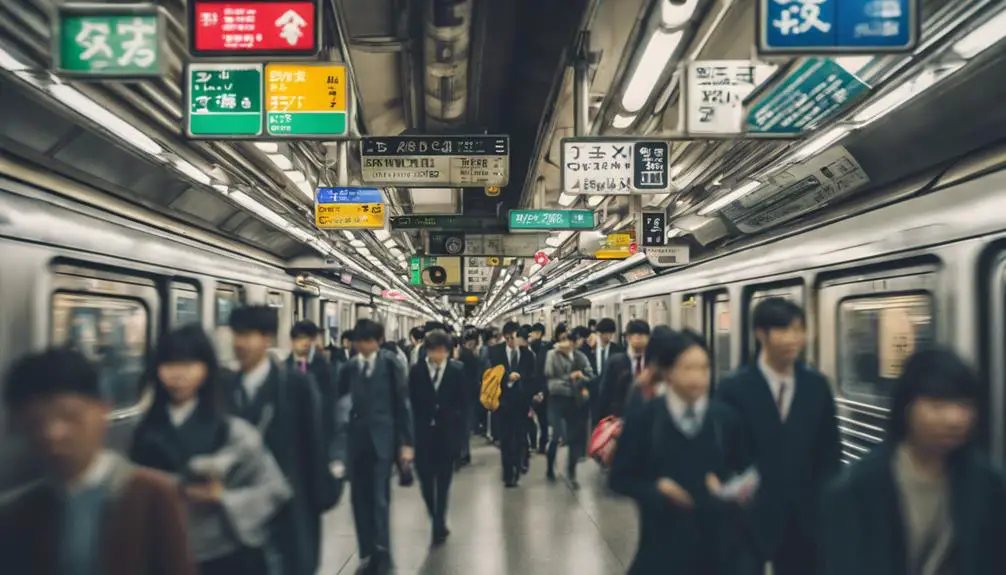
Maneuvering Tokyo's subway during rush hour requires a strategic approach to avoid the overwhelming crowds. You'll want to plan your travel times wisely; aiming for slightly earlier or later than the peak hours of 7:30 to 9:30 AM and 5:00 to 7:00 PM can save you from the worst of the congestion. If your schedule's flexible, consider traveling outside these windows.
When you're stuck traveling during these times, aim for the first or last car, which are often less crowded than the middle ones. Keep an eye on the station's electronic boards; they sometimes indicate which parts of the train are busiest. Opting for a spot near the doors can make your exit quicker, though it's a bit riskier regarding space during peak times.
If you're not in a rush, waiting out one or two trains to catch a less crowded one is a smart move. It's also helpful to position yourself on the platform where the train doors will open. Stations often have marks on the platform indicating where doors will be, saving you from having to navigate through a packed car when it's time to disembark.
Accessibility Features
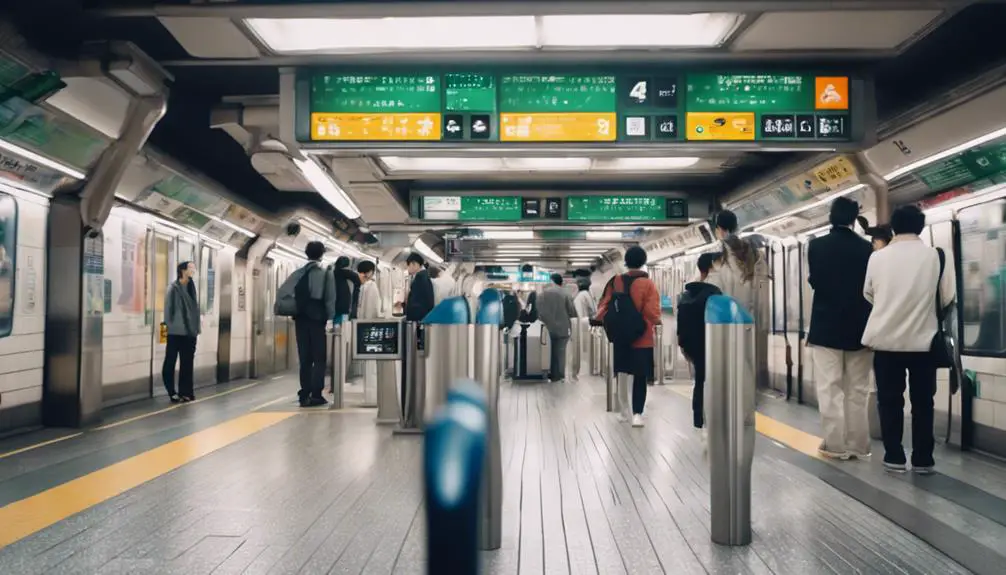
As you explore Tokyo's subway, you'll find that accessibility is a priority.
Stations are equipped with wheelchair-accessible entrances, and visual assistance resources are readily available for those who need them.
Additionally, you can always find priority seating to guarantee a comfortable journey.
Wheelchair-Accessible Station Entrances
You'll find that many Tokyo subway stations feature wheelchair-accessible entrances, making navigation smoother for everyone. This inclusivity guarantees that you can enjoy the bustling city without unnecessary barriers, regardless of mobility limitations. Each station with accessible features is clearly marked with universally recognized symbols, so they're easy to spot.
Here's what you should know about these accessible entrances:
- Wide Automatic Doors: These guarantee that entering and exiting is a breeze, even if you're using a wheelchair or other mobility aids.
- Ramps and Slopes: Strategically placed to avoid the necessity of stairs, making it easier to maneuver from the street level right onto the platform.
- Tactile Paving: While not directly related to wheelchair accessibility, these paths help guide to the accessible entries.
Visual Assistance Resources
While the city guarantees physical accessibility, Tokyo's subway system also offers several visual assistance resources to support travelers with visual impairments. You'll find tactile paving throughout the stations, guiding you from entrances to platforms safely. These tactile paths are especially handy if you're steering through the complex interchanges.
Audio cues are another critical feature you'll appreciate. Announcements in both Japanese and English help you keep track of your location and upcoming stops. Plus, the newer trains have electronic signs that display information in multiple languages, including braille options near the doors.
Check out this quick reference table for a snapshot of the visual assistance features available:
| Feature | Description |
|---|---|
| Tactile Paving | Grooved paths at stations to guide walking routes |
| Audio Announcements | Frequent updates in trains and stations |
| Braille Signage | Signs near train doors and key areas |
| Electronic Signs | Displays in multiple languages, including braille |
Don't hesitate to use the station maps and mobile apps that provide real-time assistance and directional tips. These tools are designed to make your travel experience as smooth and stress-free as possible. Remember, you're just a tap away from all the help you need to enjoy Tokyo's vast subway network.
Priority Seating Availability
Most Tokyo subway cars feature clearly marked priority seating, ensuring accessibility for those who need it most. These seats are designed to provide convenience and comfort to passengers who may find it challenging to stand during their commute, such as the elderly, pregnant women, individuals with disabilities, and those carrying small children. You'll find these seats located near the doors for easier access.
When you're using the subway, it's important to remember that these seats are reserved for passengers who need them.
Here's what you need to know about priority seating:
- Visibility: Priority seats are marked with signs and often have a different color or pattern to stand out.
- Etiquette: It's expected that you offer these seats to passengers in need before taking a seat yourself.
- Awareness: Keep an eye out for badges or tags that indicate someone might require a priority seat.
Navigating With Apps
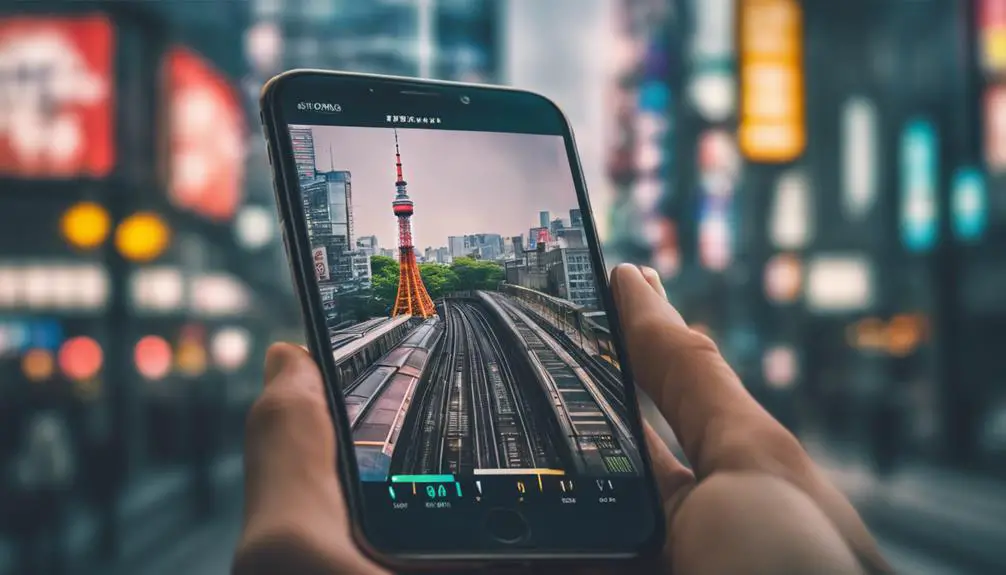
Finding your way through Tokyo's sprawling subway system becomes considerably easier with the help of dedicated smartphone apps. These apps not only provide you with real-time updates and navigational tips but also interface seamlessly with local languages and English, making them indispensable for any savvy traveler.
Here's a quick look at some top apps you should consider downloading:
| App Name | Key Feature | User-Friendliness |
|---|---|---|
| Tokyo Subway Navigation | Real-time directions | Highly intuitive |
| Japan Travel by NAVITIME | Extensive route options | Easy to navigate |
| HyperDia | Accurate train schedules | User-friendly |
| Google Maps | thorough coverage | Very accessible |
These apps do more than just point you from point A to point B. They enhance your journey by showing you multiple route options, expected travel times, and transfer points, all updated in real-time to account for any service changes or delays.
You'll find that using these tools not only saves you time but also provides a peace of mind, allowing you to enjoy the bustling city rather than worrying about your next subway transfer. So before you step out, make sure your phone's loaded with at least one of these apps—it's your key to mastering the Tokyo subway like a pro.
Etiquette on the Subway
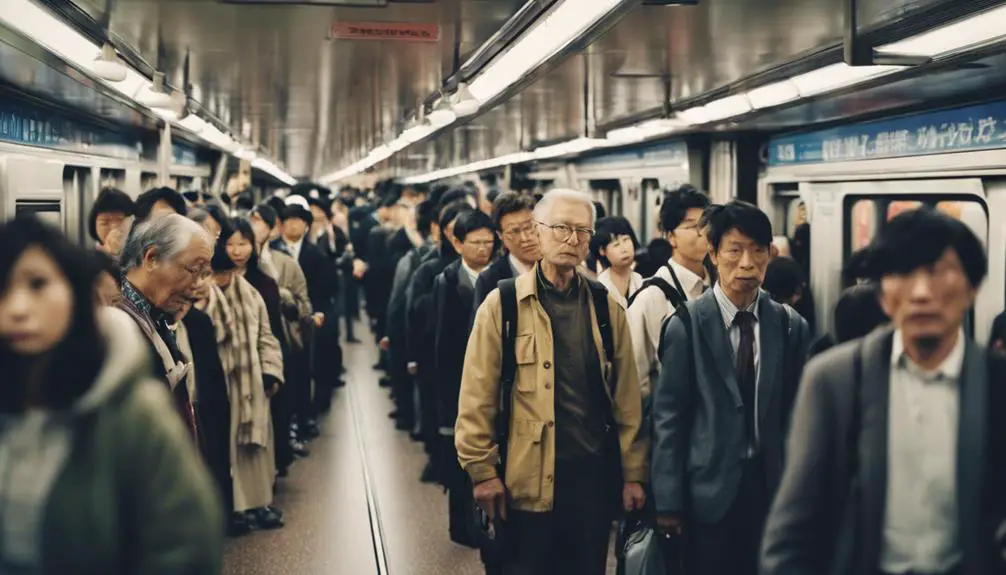
Understanding the etiquette of Tokyo's subway is essential to maneuvering the system respectfully and efficiently. As you navigate through the bustling platforms and trains, knowing the unspoken rules can greatly enhance your experience and guarantee you're not inadvertently offending anyone.
Firstly, always stand on the left on escalators; the right side is for those in a rush. It's a simple act that keeps foot traffic flowing smoothly and prevents bottlenecks.
When boarding the train, wait for passengers to disembark before you step in. Rushing ahead creates unnecessary chaos and can be seen as impolite.
On the train, it's common to prioritize silence over conversation. If you must take a call, use a low voice or text instead. This consideration maintains the calm environment that many commuters appreciate after a long day.
Lastly, be mindful of your belongings. Backpacks and large bags should be held by your side or placed at your feet, not on the seat next to you. This guarantees everyone has a place to sit during busy hours and shows respect for your fellow passengers.
- Stand on the left side of escalators.
- Allow passengers to disembark before boarding.
- Keep conversations quiet or text instead.
Top Stations to Know

You'll benefit from familiarizing yourself with a few key stations in Tokyo's subway system.
First up, Shinjuku Station, the busiest in the world. It's your gateway to major shopping districts and connects you to most lines. It's easy to get overwhelmed here, but remember, there are plenty of signs and maps to guide you.
Next, Shibuya Station is essential for its famous scramble crossing and fashion streets. It connects with the Yamanote Line, making it a hub for transferring to other major areas. Keep an eye out for the Hachiko Exit as a popular meeting spot.
Tokyo Station, another important hub, serves as the main intercity rail terminal. It's especially useful if you're planning to take the Shinkansen. Plus, it's linked to numerous subway lines that can whisk you off to various city corners.
Lastly, don't overlook Ikebukuro Station, a less touristy but equally important station. It offers access to shopping malls and entertainment options, and is a key station for exploring northern Tokyo.
Knowing these stations will streamline your travel and help you navigate the sprawling Tokyo subway with more ease.
